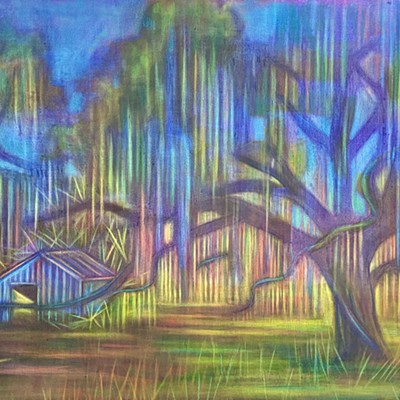In our era of mass production, the unique, handcrafted object loses its use value as a utensil or a piece of furniture and is raised to priceless fine art status, to be exchanged at auction for vast sums. But ours is also the age of reproduction and repetition, and a unique object becomes merely a prototype to be infinitely repeated.
Time itself is the victim of this hysterical reproduction and consumption; time becomes a commodity to be used up and it can never pass fast enough to suit the demands of contemporary life. These conditions are hardly conducive to creativity, but they are perfect for imitation. No professional artist or craftsman can now afford to spend years on one work. Production deadlines require not reverie, but speed and multi-tasking
Crammed into one dimly lit room in one of the SCAD buildings, there are currently two exhibitions, ostensibly united by the theme of plants and flowers, but whose real connection would seem to be the questions they raise about archaic techniques, craftsmanship, authenticity and reproduction.
Albert Robert Valentien (1862-1925) spent the first 24 years of his adult working life as a pottery designer and decorator. While recuperating from an illness, he took up flower painting and in 1908 he was commissioned to paint a complete series of California wildflowers, which for the next ten years became his life’s passion. Traveling the length and breadth of California, he created over 1000 watercolor paintings depicting detailed and accurate illustrations of 1500 species of wildflower. A good sized sampling of this project is displayed closely-packed in a double row on all four walls of the gallery.
Botanical drawing, like all scientific illustration started to become obsolete with the invention of the camera. The establishment of the computer as the essential tool in our lives has completed this process. Valentien, however, was not a naturalist, but a craftsman, whose medium was paint. Flower painting is neither botanical illustration nor is it the self-expression of fine art, but a genre of the decorative arts, now easily dismissed as anachronistic.
But if viewers can spare the time to look closely at these works (hampered by the low lighting and high placement of the top row), they reveal humility in front of the subject, a search for descriptive accuracy and joy in the labor involved.
The charming Lewisia cotyledon, var. howeleii, is named after Meriweather Lewis of Lewis and Clark fame. Here, Valentien has used light brilliantly to show veins on the underside of the leaves. As tenacious as its namesake, we are told it clings by a stout taproot to rocky outcrops and wedges itself into crevices and cracks on canyon walls.
Then there is the cow parsnip, a member of the carrot family, whose other members – caraway, dill and coriander - have familiar herbal use. A less friendly relative is the Poison Hemlock Socrates took. The drawings are in color and all on a grey paper background, the better to clearly show any white parts of a flower or seed.
Many of these plants are listed as endangered species. Which nicely segues into the next exhibition, artifacts carved from the wood and roots of the endangered Red Sandalwood tree by hundreds of artisans from all over China, using the ancient methods that extend back 1000 years.
On a long table running through the center of the gallery, there are a number of these intricately hand-carved objects, incorporating the traditional symbols – dragon and phoenix, plum blossoms, peonies, clouds, flames, sea and mountain views, as well as emblems of the seasons. Some are in Sandalwood and others in mahogany, ebony, boxwood and rosewood.
But it is the Sandalwood that catches the imagination: “an inch of Sandalwood is worth an inch of gold.” And like all fabulous and precious botanicals, this tree that can take a hundred years to mature, is thought to be endowed with healing powers. Another mysterious characteristic is that it grows hollow as it develops, but its density is such that when submerged the wood will sink.
What strikes the viewer is the perfection of the craftsmanship. Almost too perfect. The works have been provided by the China Red Sandalwood Museum in Beijing, founded by Chan Lai Wa, the wealthiest woman in China and recipient in 1999 of an honorary doctorate from SCAD.
But what is unusual about something that calls itself a “museum” is that it houses very few original works from the Ming Dynasty (1550-1643) and early Qing Dynasty (1644-1750), known as the Golden Age of Chinese furniture, but instead, showcases these recently made replicas of the originals that exist in the Beijing Palace Museum. We should ask then what is the difference between an original work made exclusively for imperial use during the Ming and Qing dynasties and its 21st Century imitation? According to much of the writing on the subject, the material is equally valuable but the modern craftsmanship in the replicas is superior to that of the originals. One writer on the subject of a replicated screen shown at the World Expo in Japan in 2005 wrote: “The artistry is equal to and may even surpass that of the original. It can be called a masterpiece.”
It is certainly increasingly true that the simulation satisfies the contemporary need for perfection in appearances. We now have the technology to discover the techniques used by the Old Masters and the ability to reproduce them easily. But something is missing and it cannot be explained through mystifications about the loss of ancient spiritual and transcendental values or babble about genius.
It seems to me that the human drive for expression allows for imperfections. Flaws are inherent in art, just as they are ironed out in the merely copied product. But in this world full of replicas, we have become increasingly incapable of distinguishing between the authentic and the imitation. If we had to choose, we would probably be open to the seduction of the perfect imitation over the flawed but inspired creation.
But let’s not be too bleak. There is another way of looking at all this. As a 20th Century craftsman, Albert Robert Valentien had an identity, a name and a biography. The modern artisans of the Red Sandalwood Workshop would appear to be anonymous. The 21st Century could be described as the Age of Forgery. The forger, of necessity, must remain in total anonymity. Therefore, he is also the purest artist, the one who rejects the cult of personality, who has no identity and no personal style, who believes only in the work itself and the age to which it is attributed. The forger, in the end, may be the model artist. ç
























